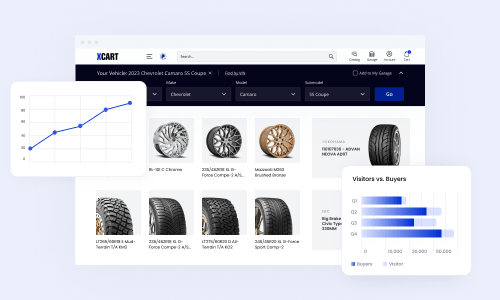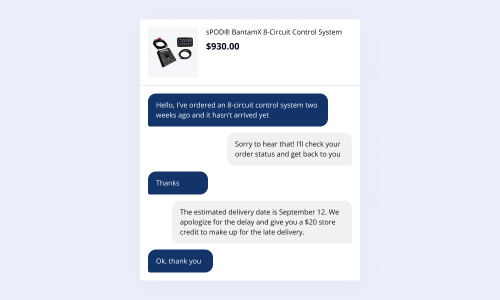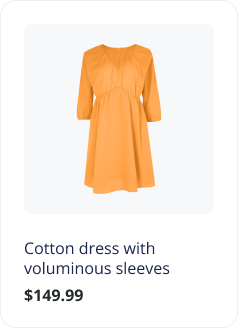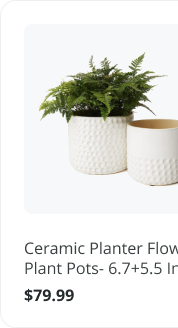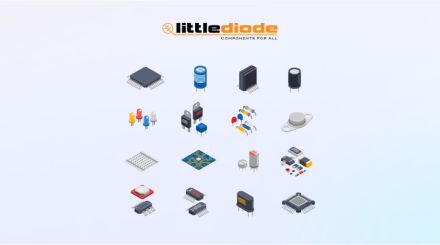How to Start a Multi-Vendor Website: Ideas, Pros, Cons, Launch, and Growth

Exactly as huge physical malls have pushed out shops of narrow focus, multi vendor marketplaces do so towards unpretentious online stores today.
So, what do we see?
Some merchants just close their sites and benefit from the power of eCommerce giants. They successfully sell on such multi vendor sites as eBay, Amazon or Etsy. Others invest a lot into their online stores not to lose in this fierce competition.
And the most ambitious online merchants take advantage of the trend and build their own multivendor websites.
To teach you how to start a multi-vendor website and save your time on research we’ve created a step-by-step plan. This beginner guide to setup a multivendor website has almost everything you should know before and during the launch.
You’ll learn what markets types exist and will see famous multi vendor site examples. We’ll also walk you through the advantages and pain points of marketplace business model, must-have features of multi-vendor eCommerce software and growth steps.
What is a Multi-Vendor Website?
In a nutshell, a multi vendor marketplace is a site containing offerings from multiple sellers (vendors, suppliers).
All suppliers pay a wise commission for selling in the marketplace. They have their own seller accounts where they manage their inventory themselves.
But it’s the marketplace operator who processes all transactions. It’s a win-win cooperation, as the multi vendor marketplace website owner gets inventory, and sellers get buyers.
In simple words, starting a multi vendor website is the same as creating a marketplace like Amazon or eBay of your own. Hope it’s more clear now.
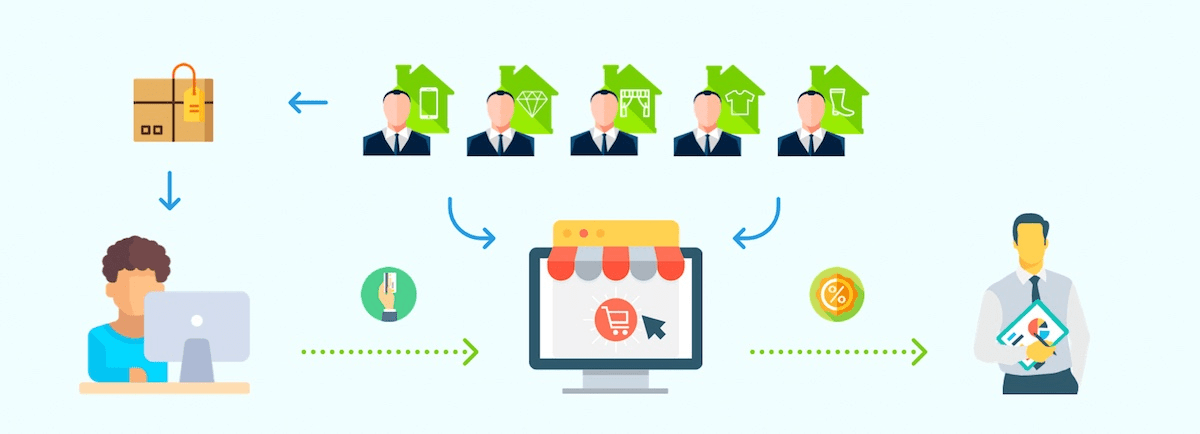
Often, the term eCommerce marketplace is accompanied by the term disruption which means changing the traditional way the industry operates. Put simply, under-served markets get served, and over-served markets start delivering a better or cheaper product and better customer experience.
Of course, starting and managing a virtual marketplace is not the same as a single vendor online store. There are a plenty of differences. With unique business opportunities, a multi seller marketplace operator faces new challenges.
I. Online Marketplaces Business Models
Most often, under the term ‘multi vendor marketplace’ we understand a huge online mall where multiple vendors sell physical products of different categories to a wide audience of consumers. The biggest players are eBay, Amazon, Aliexpress, Walmart, Jet. These are the so-called ‘one-stop-shops’ selling everything to everyone.
However, today’s trend is niche marketplaces. Such trading platforms unite suppliers that sell goods or services for a specific industry, profession or demographic, i.e., their focus is a single niche, a single category of products, customers or businesses with specific needs.
Niche marketplaces are usually of small and medium-size due to the product range limitation. But they are true specialists in what they do and usually prove a great shopping experience to their buyers. Airbnb (worldwide accommodations) and Fiverr (freelance services marketplace) are good examples of such eCommerce marketplaces.
The scale is not the only difference. Before you start your own virtual marketplace, make sure you know who will sell there, what, to whom and how.
The examples below will show how differently online multi-vendor marketplaces operate.
Brands
Let’s compare Amazon and Uber. Both multi vendor sites operate as an intermediary between sellers and buyers. However, selling on Amazon, suppliers use their brands, while Uber drivers provide their services under the same brand.
Another distinct is price and quality. Selling on Amazon allows offering similar goods and services of different price and quality. On Uber, the quality of the provided service and the price are standardized. There is a good reason for such standardization. It is a part of building your own brand. Other examples of multi vendor marketplaces that sell under one brand are Oyo, Munchery, FoodPanda, and Grofers.
Vendors And Buyers
The most common model for multi vendor marketplaces is B2C, which means vendors in your online mall are different businesses who sell their products to your customers. Examples are Newegg or 3tailer.
However, a seller doesn’t always have to be a manufacturer, and a buyer is not always an individual consumer.
Some multi vendor stores work mainly as B2B model where businesses buy from businesses, like Alibaba, Thomasnet, Tradeindia.
In C2C marketplace websites or also called P2P, customers sell to each other and buy from each other. This is the way Panjo and DogVacay work.
Often, an eCommerce marketplace can successfully combine these business models, like Etsy, eBay and Amazon do. There are product listings from both businesses and customers on these eCommerce websites.
Supply
To the difference with brick-and-mortar malls, multi vendor marketplaces can boast a variety of product types and use cases. The limitation is merchants’ creativity and the ability to see, what people need.
Physical Goods

The most obvious case of eCommerce trading platform is where multiple vendors sell different physical products online. Vendors manage their product lists themselves. As a rule, they’re also responsible for shipping and managing of their orders. This is the way Amazon, eBay, Aliexpress, Walmart, Flipkart, Tictail work.
Sometimes, it’s a marketplace operator who handles shipping and provides a warehouse for the vendors’ goods, like Sears does.
Digital Goods

It’s another popular thing for selling online. The digital products imply a whole range of downloadable products: photos, images, music, games, software, pin codes, keys, and whatever can be distributed via the Internet as a one time or subscription based sale.
G2A sells games. Envato market sells multi vendor marketplace themes and templates, ready scripts and plugins, video effects, audio, fonts, logos, photos, as well as 3D print models and CG textures. On Stubhub, you can buy event tickets, and on Udemy – educative videos.
Customer to Customer

It’s an interesting case. Anybody can list any products as long as they meet the eCommerce store focus. It can be new or used things. Handmade is very popular nowadays, and many do-it-yourselfers have gained such a level of quality that they can sell their handcrafts, such as toys, jewelry, clothes, paintings and even furniture to others.
Such markets often turn into communities. People with common interests can not only sell their handmade items but also discuss their hobby, share ideas and exchange related things. LoveCrafts, Zibbet, Panjo and Artpal are bright examples of such marketplaces.
Services

eCommerce Marketplaces like Fiverr, SkillShare and Rover gain more and more popularity. It has never been easier to find competent specialists and experts in specific areas to develop a complex project or just make some easy task for you.
Appointments and Rentals

If your offline business is related to booking and rentals you can also make maximum use of multi vendor eCommerce. Here are a few examples: Bedandbreakfast, Booking, and Airbnb for accommodation, StyleSeat and Spakhoj for beauty and gym appointments, ToolMates for equipment rentals. Their success proves the efficiency of such online marketplaces.
RFQs & catalogs

There exist multi vendor marketplaces of RFQ and Catalog type. Buyers can browse offerings of multiple manufacturers or service providers but don’t make a payment right away. They need to submit a request for quote or contact a supplier before finishing the order. Such marketplaces are good for orders that need additional information and individual discussion before the final estimation. This is the way 99designs, Global Sources, and E-steel work.
Auctions

Some online marketplaces work as auctions like eBid and Invaluable. By the way, eBay was initially founded as auction website for collectors.
Donations & Fundraising

Finally, an online multi vendor marketplace may be not for selling, but represent a platform for charity, donations, investment and fundraising, like Kickstarter, Circleup, and Indiegogo.
Now when you’ve got the examples, you can explore the arrangement of the eCommerce marketplaces that are most close to your idea. It will help you to define the features your site should possess, think out the ways of monetization and adopt a couple of cool marketing tricks they use.
If you haven’t decided upon your supply yet, browse Craigslist categories for more inspiration on things and services for selling online.
II. Why Opening a Multivendor Website is a Good Idea
Besides delivering a better experience to consumers, multi vendor stores offer new opportunities and benefits to businesses. So, why in the world you’d ever want to start your marketplace or switch to this business model from a single-vendor eCommerce store?
- First and foremost, you no longer need to manage and invest in inventory. A marketplace operator earns on transactions commissions while vendors manage products themselves, which also means:
- Less financial risks because you don’t invest in your site inventory.
- Fewer management efforts as vendors manage and ship their products themselves. However, you’ll have to learn a little bit about the vendor management.
- More time and funds for development, growth, and promotion.
- Expanding supply is easier and quicker.
- You can start selling new products and product categories just by welcoming new vendors without any risks and thorough demand analysis.
- There are small sellers who have little inventory and hence it’s too expensive for them to run their own site. Such vendors will be glad to sell on your marketplace.
- You’ll see more buyers.
- Wide choice of products and new experience will attract more customers to your eCommerce website that in turn will attract more vendors.
- Buyers consider big marketplaces more secure than small online stores and are more likely to make a payment.
- Multi vendor marketplaces establish a new seller buyer relationship and become a trusted and convenient way of communication for them.
- Competition in online marketplaces encourages vendors to lower their prices. Buyers love low prices.
- It’s easier to promote your site.
- Your sellers will become your promoters especially those who sell only on your marketplace. They will share news on their listings that will attract new visitors to your eCommerce site.
- If you run a niche marketplace, it resolves the problem of choosing the right audience to target. You sell products for a particular group of consumers, you know who they are, how to serve them, what benefits your business gives them.
- A big choice of products that meet needs of a particular customer segment makes you a leader in this area.
- Marketplace business models boost chances to start global sales as you can welcome buyers and sellers from all over the world.
- eCommerce Marketplace is more likely to raise investment. Online sites developed according to such business models have a higher potential for success, and that’s why are very interesting to investors.
- Increased scale of your business brings new exciting and beneficial partnerships.
- You can successfully combine several business models if you run a big marketplace: sell both products and services and let both businesses and customers sell to each other.
- Network Effect will render an excellent service to your marketplace in terms of scaling if you manage to find one. In simple words, the essence of the network effect is that every new user increases the value of your marketplace for other users. As a result, they start shopping in your marketplace.Social networks brightly illustrate this value. The more users register in the network, the more friends one can find there, the more interesting posts from different authors appear, the more people to exchange information with, etc.
As for online eCommerce, there are several network effects:- Buyers benefit from buyers. They can see how many times the product was bought, read reviews from other buyers and hence be able to choose the best supplier among all listed in the marketplace.
- Buyers benefit from vendors. The more sellers start selling on the marketplace, the better choice customers get.
- Finally, vendors benefit from vendors. More sellers result in registration of more buyers, and it makes the eCommerce market more valuable for other sellers. Also, the more users register on a marketplace, the more it scales. For example, thanks to the Uber popularity, drivers from more countries and cities register in the application, and hence travelers get a better service as wherever they go, they know how to get a ride.
III. Multi Vendor Website Challenges & How to Deal
If you decided to build online marketplace, be prepared to the challenges you’ll have to overcome.
Online Marketplace requires a bigger startup budget than a single-vendor eCommerce store. I’m referring not only to the website development part. The launch will require another portion of investments.
And here comes another challenge – find investors and persuade them why your marketplace is lucrative.
- You’ll face the chicken and egg problem. Online marketplace startups need to attract buyers and sellers, but the former won’t like the eCommerce website with poor choice and vice versa the latter won’t start selling on your marketplace unless they see that it’s popular among buyers.
- Once you resolve the chicken and egg problem, you’ll need to match sellers and buyers, help buyers reach the right sellers and present the sellers’ offerings to the right buyers in the right moment. It presumes a well thought-out search, navigation, machine learning technologies and promo tools.
- Next, it’s essential to establish and maintain perfect customer and vendor experience. Vendors won’t seek an alternative sales channel if they are satisfied with your terms and conditions, your site traffic and your assistance. Meanwhile top-notch service and relevant product choice or even unique experience will ensure the loyalty of your buyers.
- You should also attain high performance. As a rule, the primary source of income for online marketplaces is a commission fee which is less than the product margin. So you need to sell more to gain good revenue.
- Finally, you have less control over your store, as vendors manage their listings themselves. You’ll have to find the ways to keep an eye on the quality of these listings, products and services to see who does best and who ruins your brand. Constant monitoring will help to take timely measures.
IV. How to Start a Multi-Vendor Website
To be specific, the multi vendor eCommerce market should possess certain characteristics to win the competition, not necessarily all at a time, but as much as possible. Check your idea with the list. The more “Yes” answers you have, the higher the chance is to build a thriving marketplace.
- Will your online marketplace resolve some existing problem, deliver a new experience or provide a solution that consumers can’t resist?
For example, DogVacay frees the pets’ owners from the headaches caused by searching for a good sitter and walker for their pet. No need to phone around the nearby agencies or private sitters and disturb friends and relatives, just use the convenient service to find the best sitter.
Not far to seek, one of X-Cart clients from France noticed how many people were searching for purchasing handmade items online and the lack of a good site. As a result, she created a cozy multi vendor marketplace to match handmade staff lovers and crafters — Pitimana. - Will your marketplace participants get economic advantage?
A powerful trait of a marketplace is a mutual economic benefit for its participants. For example, Fiverr allows an IT specialist from India to get a better-paid order, while the ordering party from the US gets a cheaper service to the difference with the one he could order locally. - Is your niche highly fragmented?
Make sure the niche you’ve decided to do business in is highly fragmented. It means there are a lot of sellers with similar supply and a lot of consumers with the similar demand. In this case, your marketplace will get value due to arranging the market and joining the similar small industries with the right audience in one place. - Are you going to sell frequently bought staff?
Besides fragmentation, remember about buying frequency. It’s an average number of times a consumer will return to your eCommerce market to purchase within a given period. Selling products with higher frequency use means more traffic and sales. - Is your niche market size big?
Explore the market size of your niche, how big it is, how much of it you can capture and how many participants would switch to your alternative. In some cases, marketplaces expand existing markets or even create new. Thus, thanks to Etsy, more handmade lovers can earn on their hobby. - Will it be easy to start selling in your marketplace?
Ensure hassle-free entry for vendors. The fewer barriers and uncertainty they have, the more sellers you’ll see on your market. It relates to vendor sign-up procedure, your terms and conditions, commission rates, ease of use of your platform, etc. - Are you going to use modern technologies to serve customers better?
The efficiency and popularity of your marketplace will increase if you implement modern technologies to make the shopping experience more convenient, like a mobile app to order on the go, GPS to find offerings nearby, etc. Face recognition, virtual and augmented reality, interactive apps… Monitor the newly arriving technologies and see how you can use them in your marketplace. - Will YOU control all the marketplace transactions?
It’s a marketplace who should handle transactions. In this case, it’s much easier to control and arrange payments system to the difference with offline payments or online payments going directly to vendors.
Needless to say, a modern marketplace should comply with the requirements of a modern consumer and provide better speed of communication, ultimate convenience, trust, high security, and transparency.
First Steps to Starting a Multi-Vendor Site
- Less is more. Determine your niche.
Overcome the temptation to serve all at once and do not try to build another eBay. It doesn’t mean you’ll never achieve it. Etsy started as craft supplies and tools market and have grown up into a global market.
First of all, you need to find a particular niche and give everyone a clear understanding what exactly your marketplace is about.
So, narrow your focus (ideally on what you’re really good at), determine the type and category of your services or products, your target audience segments and location. Finally, one day you’ll see that your marketplace reaches new heights. A thorough research and understanding of who they are helped our client to launch a successful prints marketplace and start selling online more effectively. - Benefit from competitors’ weaknesses
Find the way you can be better than your competitors. It can be unique inventory, a much better product/service or a lower commission rates for vendors. Implement this feature starting from the very launch and don’t forget to mention it in your ads. - Find vendors
To get inventory, you need to find suppliers. What can convince the sellers to list their products on your multi vendor eCommerce website? Prepare a strong message and do your research.
Browse the internet for a start. Check online catalogs, social accounts and interest groups, official websites, similar marketplaces, communities and professional forums, visit special events and exhibitions. Reach the potential sellers by phone and by email.
Or, if you’ve decided to go with offline to online model and your sellers are located nearby, arrange personal meetings with them. Before you manage to attract vendors, you may need to invest in your inventory or list products, available on other sites to start attracting buyers. - Attract buyers
When you’re ready to accept orders, it’s high time to invite your customers. Tell them how your marketplace can resolve their problems or what new experience it will deliver.
To attract buyers to your marketplace and promote it further, you’ll need to use various channels and marketing tactics. We’ll review them further in the article. - Focus on supply, customers, and vendors rather than development
There is no need to hire a big team to build an online marketplace and manage it. Instead, it makes more sense to find a cost-efficient open source eCommerce marketplace software which best suits your business and requires minimum effort from you.
Invest into establishing superb customer and vendor experience: build the buyer and vendor communities, offer excellent customer service and vendor assistance (operate round the clock, support and encourage your best vendors, run special offers for most active buyers, etc.). And very important – devote enough time to respond to your early adopters’ feedback and correct your marketplace arrangement and work.
Promote and Grow Your Multi Vendor Portal

Marketplace growth and promotion take time. Arm with patience and use all possible channels and strategies to attract your buyers. Let’s review the most efficient.
Each of the promotional tools and strategies, listed below, deserves a separate detailed guide and will require additional research to get best practices specific to your marketplace. This quick review is to give a general idea of the ways to promote your market and why they are worth your attention.
Before you start promotion, create your unique story and present it to your customers. It should tell them how your product can improve their lives, what pain points it resolves, how you’re different from your competitors, etc. Make your customer the main character of this story and be his fairy godmother making his wishes come true:) Promote the story, rather than your product.
Email Marketing
Since the very launch of your marketplace, start collecting email addresses of your buyers and build email lists. Retaining existing customers is as important as attracting new ones. Having bought something from you once, they are more likely to do it again.
Send them offers, news, success stories, interesting articles from your blog, etc., and you’ll see more returning customers. You can also collect emails of your prospects using forms on your site. For example, visitors can leave their email to get your company news or notifications on sale campaigns, if they’re not ready to buy right now, etc.
Modern email marketing tools allow segmenting your buyer’s list by different criteria, like activity, purchased products, demographics, etc. and send more targeted campaigns. This feature is especially useful for online marketplaces because the audience is pretty big and diverse.
SEO
SEO is vital for online marketplaces. You must be in top search results when customers are looking for the products you’re selling. The challenge of online marketplaces is the need to target both sellers and buyers, so your site content should be optimized taking into account both.
Another challenge of multi vendor marketplaces is a big number of product pages, and as you may know, search engines use links to find your content. So to have all your product pages well ranked, it’s important to take care of pagination. Kissmetrics have gathered useful tips related to its arrangement as well as internal links and backlinks, URLs structure, and content in their post.
Many multivendor shopping cart platforms have built-in tools that help improve the eCommerce SEO, like the ability to add meta information to your site pages.
Paid Ads
The paid advertising tools, like Google AdWords, boost your chances to attract more visitors from search engines.
As an eCommerce marketplace that sells numerous products in a specific niche, you can profit on long-tail keywords. Exploring such keywords and testing their efficiency to chose best performing ads may take time, but it’s worth it. It’s significantly cheaper than positioning on category related general keywords, and you’ll get better ranking due to reaching a more targeted audience.
Buyers attracted by the ads find exactly the products they searched for with their specific request, so they are more likely to make a purchase.
‘Word of Mouth’ And Viral Marketing
The more people use your marketplace, the more people start using it. Though not all marketplaces are viral, in most cases, you can use this effect to grow your business. So, make your customers want to invite their friends and relatives to start buying in your marketplace.
Adding social sharing buttons is not enough. Think what can motivate them to share – offer bonuses, coupons, update their membership level in your eCommerce marketplace, give free trial, implement a juicy affiliate/referral program, etc.
Interestingly, virality spreads faster when you target groups where members have strong connection rather than individual customers. It works exactly like virus diseases in real life. Mark Zuckerberg started growing Facebook having met groups of students of several communities.
Except for offers motivating your consumers to spread the word about your marketplace, ensure unmatched customer experience and create at least a few products or services that your buyers can’t help sharing.
Motivating Vendors
Not only customers and influencers can share your content and recommend your products to their followers. Offer bonuses, ready tools and advice to your site vendors to motivate them to promote their products.
In fact, vendors are interested in selling their products not less than you and will be glad to take part in your advertising efforts. If they sell on different marketplaces, give them strong reasons to invite buyers to yours.
Teach your sellers to make converting product descriptions and product photos, and you’ll see more sales, improved SEO, and neat product pages.
Building Community
Turn your multi vendor marketplace into a community – offer your marketplace participants convenient means to interact with each other, discuss projects, ask and answer questions, share ideas.
Blog, forum, social accounts and video content are your helpmates in the process of building the community. Thus, you grow trust and loyalty to your brand and give customers more reasons to come back to your marketplace and spend more time there.
Social Media
Facebook, Twitter, Instagram, YouTube, Pinterest and other social media networks are not only about building community. You can take advantage of these channels to cultivate your brand’s online presence and awareness.
Some customers prefer to use this channel to contact brands about the purchase or if they need assistance. To make the most of the social media, you can also ask influencers to share your posts and reach thousands and even millions of their followers.
Multi Vendor Website Design
OK, much is spent on promotion and advertising, customers are here – on your homepage or campaign devoted landing page. Not yet a win!
Poor site design may reduce your efforts to zero. And vice versa, a beautiful responsive multi vendor eCommerce theme, well-thought layout and convenient navigation will help you skyrocket your sales. Get inspiration in these 23 examples of converting sites.
Measure, Analyze and Improve
Marketplace growth without tracking and exploring the main metrics is out of the question.
When you launch, you’ll check dozens of best practices and implement them as custom design changes or additional features on your eCommerce site. But how do you know what really helps and what causes sticking points, which changes and strategies are worth your efforts and which are just a money pit?
From the very launch, you should monitor main marketplace metrics and update your marketing strategy accordingly. Besides these indexes explore your customers’ behaviour at every step of your sales funnel to make your eCommerce marketplace more converting.
V. Must-Have Features of Robust Multi-Vendor Websites
Ready to start searching for an eCommerce software for your online marketplace or hire eCommerce developers? You need a technical specification. So, open your notebook and make a list of requirements for your site arrangement.
Though each multi vendor marketplace is unique, there are standard features. Let’s review them to help you start your list.
Seller Dashboard
Each vendor needs a separate seller account where they will add their products, create special offers, add shipping methods, manage shipping cost, get sales reports, request payouts, get notifications on the low stock, new orders or new customer messages, etc. Remember, they’re not techies, so the interface should be very user-friendly.
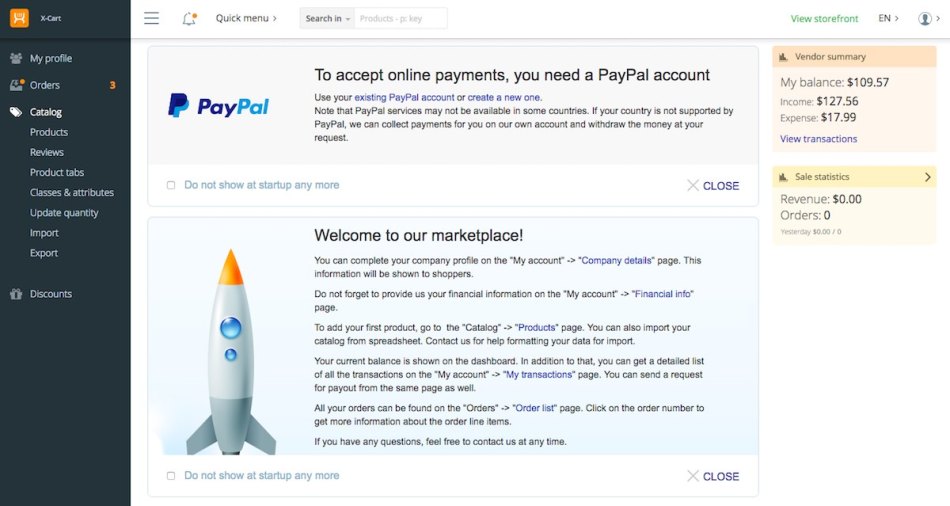
Inventory
Inventory management should be easy for your sellers. Based on the product types you’re going to list on your market, think what functionality you’ll need in your multi vendor eCommerce system.
For example, if you sell clothes, you need the ability to set product options and attributes, like size, color. If you sell rentals, there should be a calendar where a customer will pick dates. If you sell software, you need an easy digital downloads tool which allows adding a file for each product and have it automatically sent to the user who placed the order.
Will your products have the same prices for all or depending on customers memberships? Or your site may work as a catalog and customers should contact you or fill in a questionnaire to request a quote.
Modern multi vendor eCommerce platforms provide an opportunity to add and edit products in bulk which will save the time of your vendors and help them keep their inventory current.
To ensure good quality of your product descriptions and product images, you should be able to approve or disapprove your vendors’ products, i.e., the product will not appear in your storefront until you accept it.
Low stock automatic email notifications will help vendors to control their stock. Otherwise the lack of the purchased items and, as a result, long delivery will result in complaints and dissatisfaction of your buyers.
Transactions
At best, transactions should be a part of your eCommerce marketplace operation. The transactions flow combines payments from consumers, fees from vendors and payouts to vendors.
For customer payments, there are two important things to do – give your customers a choice of several payment methods and ensure payments security both for your business (fraud protection) and for your customers (PCI-DSS compliance).
Having several payment options increases your checkout page conversion rates. And strong security is a must at least for building trust with consumers. Some payment gateways offer hosted payment forms, thus undertaking your PCI compliance efforts, others require you to take care of security. In the latter case, such tools as X-Payments will be of great help. Here is the list of most popular payment gateways.
Seller fees are your source of revenue, and at the same time, they are your sellers’ payments for using your eCommerce marketplace. These fees should be reasonable not to drive away vendors but to keep your project profitable.
The most common option is a commission – a percentage or a flat fee deducted from the order total. Such tools as PayPal Adaptive Payments make the process of charging the fees and transferring vendor earnings automatically which saves you a lot of time. This model is very attractive for sellers as they pay only when they have earned. You can have a global commission rate, the same for all sellers. However, you may want to favor your best sellers and make lower individual commissions for them. In some scenarios, it’s an excellent idea to entirely waive it for your early adopters.
If commissions do not work for your multi vendor marketplace you can charge subscription fees (fixed for all or based on memberships), fees per listing or fees for access to leads’ contact information.The whole process of managing transactions should be optimized to require minimum manual work from you.
Orders Fulfillment
To minimize your efforts, you can give your vendors full access to orders management system. Let them edit existing orders and create new on behalf of customers, make full and partial refunds.
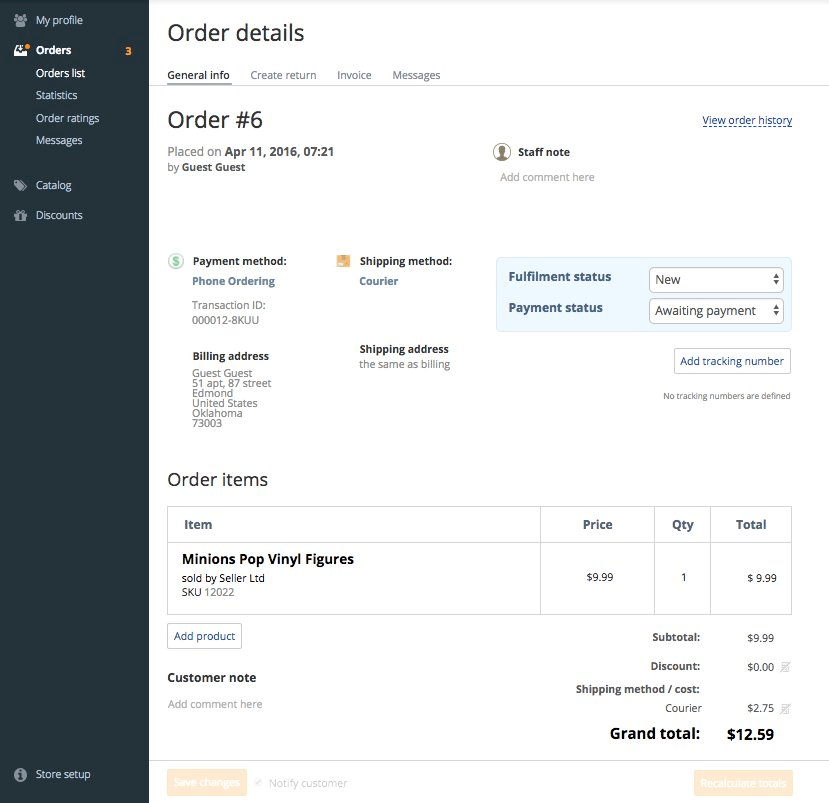
Anyway, as a store administrator, you should keep the orders fulfillment process under your control. Its quality directly impacts your customers’ satisfaction. You should have access to all orders placed in your marketplace and be able to filter them by status to check their timely processing.
Enable vendor and customer notifications, so that the former know right away when an order is placed, and the latter are well aware of their order status and updates.
Unless your eCommerce marketplace operates as a warehouse (when all products are shipped from the same location), it makes sense to allow sellers to fully manage their shipping methods, too. While some of them prefer delivery by courier or local pickup, others may want to use services from shipping carrier companies. Integrating these services with your marketplace platform will enhance your vendors’ experience.
Ratings and Reviews
Customer ratings and reviews are an essential part of a converting multi vendor marketplace. Let customers rate products, the accuracy of descriptions and orders fulfillment.
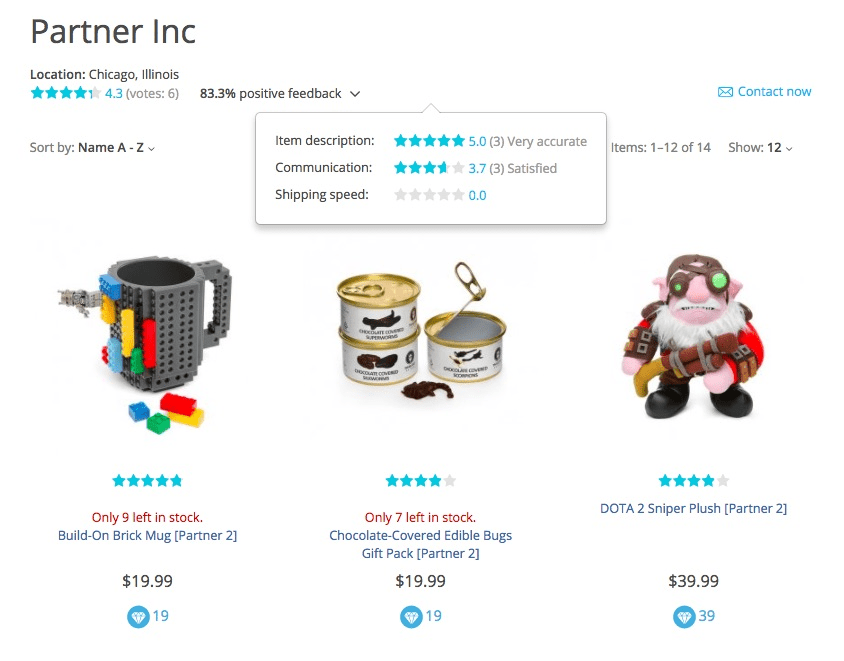
Good reviews will encourage other customers to make a purchase, and bad reviews will force vendors to do better. It’s an additional source for you to see how well your sellers do. Admins and sellers should be able to reply to these reviews.
Customer reviews are also advantageous for SEO. You can boost the effect if you integrate with reviews services like ShopperApproved.
Search Tools And Navigation
An eCommerce marketplace distinct is a big stock with a variety of offerings, which requires a robust search and navigation system to help customers find exactly what they need.
A convenient and commonly used feature is filters. Your buyers should be able to filter not only by such general things as price, brand or category but by product options specific to products of the given category. Such filtering tool narrows down search results to just a few products that match the buyers’ requirements.
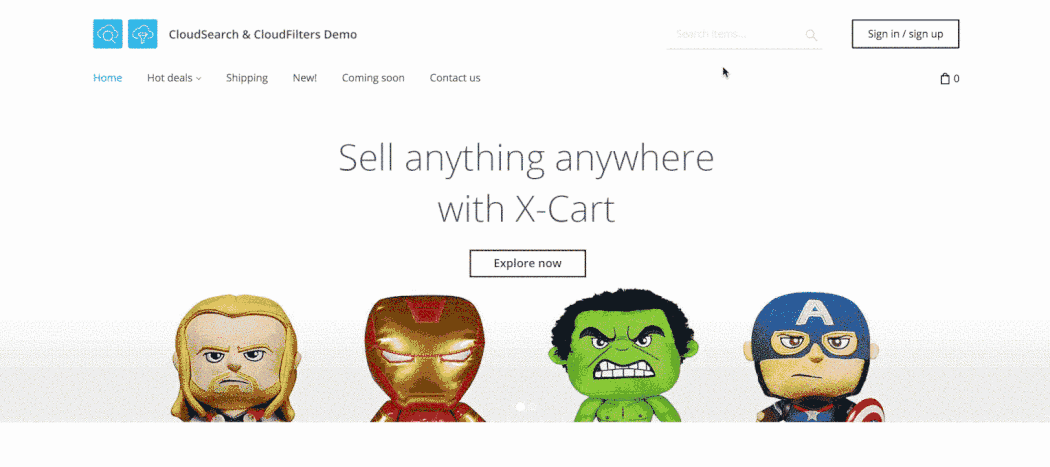
However, there are other tricks to simplify the search process. When filters are not an option, you can ask your store visitors to fill in a quick survey and offer a list of products or services based on their answers.
If your business is present offline, consider adding a map. In combination with GPS, it will simplify the search for offerings or store locations nearby.
Machine learning technologies are a fresh and efficient way to increase sales. They allow promoting products to the store visitors following their behavior and recent activity.
To please customers loyal to particular sellers, you may establish a separate vendor store for each seller in your online marketplace with the ability to search among this seller’s products only.
If customers don’t manage to find what they need, make sure they can quickly reach you or your sellers via a ‘Contact us form’, by chat, by email, etc.
As a store admin, you should have full access to seller profiles information, orders and inventory management. Besides, your admin panel should have at least basic reporting tools, to check the performance of each vendor, overall store sales, best-selling products, etc.
And remember, a well-chosen multivendor shopping cart software and other related eCommerce solutions will significantly cut your efforts.
To Sum Up
Though these are the very basics on how to start a multi vendor website, now you’ve got inspiring examples, direction, and know what important things to consider before investing in your project, choosing a multi vendor eCommerce platform, launching and promoting it.
How Can X-Cart Help You Create a Multi Vendor Marketplace Website?
Along with providing hundreds of eCommerce plugins, X-Cart multi-vendor eCommerce system stands out against competitors due to virtually unlimited customizability which allows fine-tuning and extending your eCommerce market according to your business needs at every step of its growth.
Besides Enterprise eСommerce software, we also provide eCommerce Solutions with a whole range of on-demand services from true professionals: design and custom development, technical support, hosting, etc. to have it easier to build online marketplace and to maintain it.
X-Cart open-source multi-vendor software is a powerful eCommerce marketplace solution to help you launch and manage a big website with as many sellers and products as you need.

Maria is a marketing manager at X-Cart. Once captured by digital and content marketing in her student days, she keeps living and breathing it ever since.

